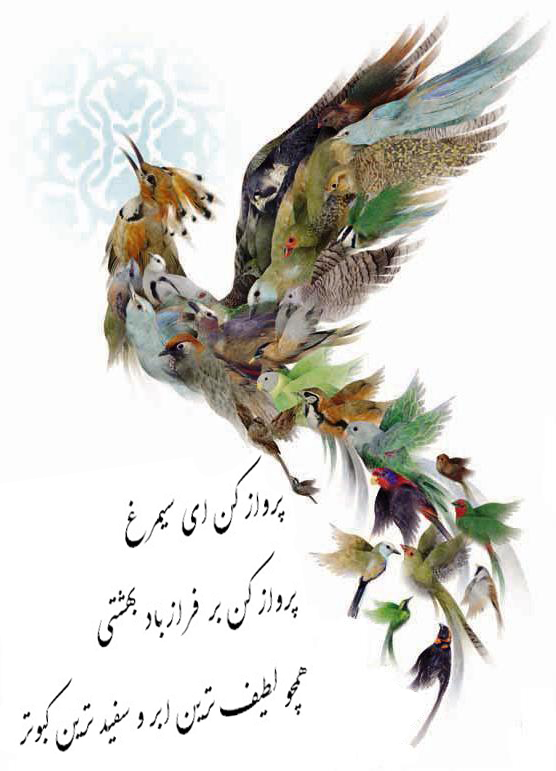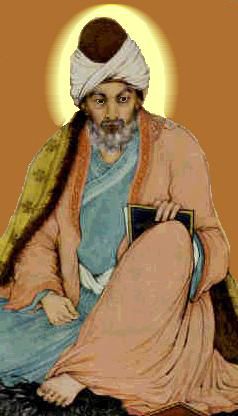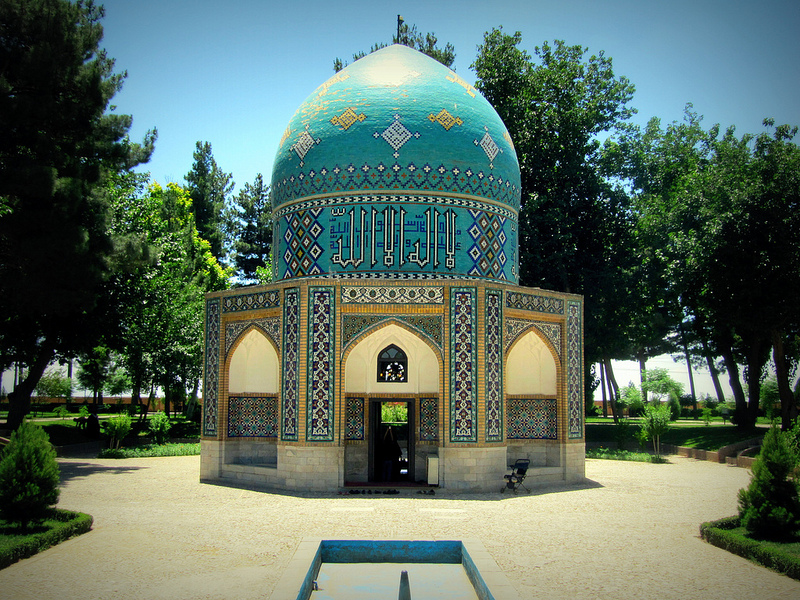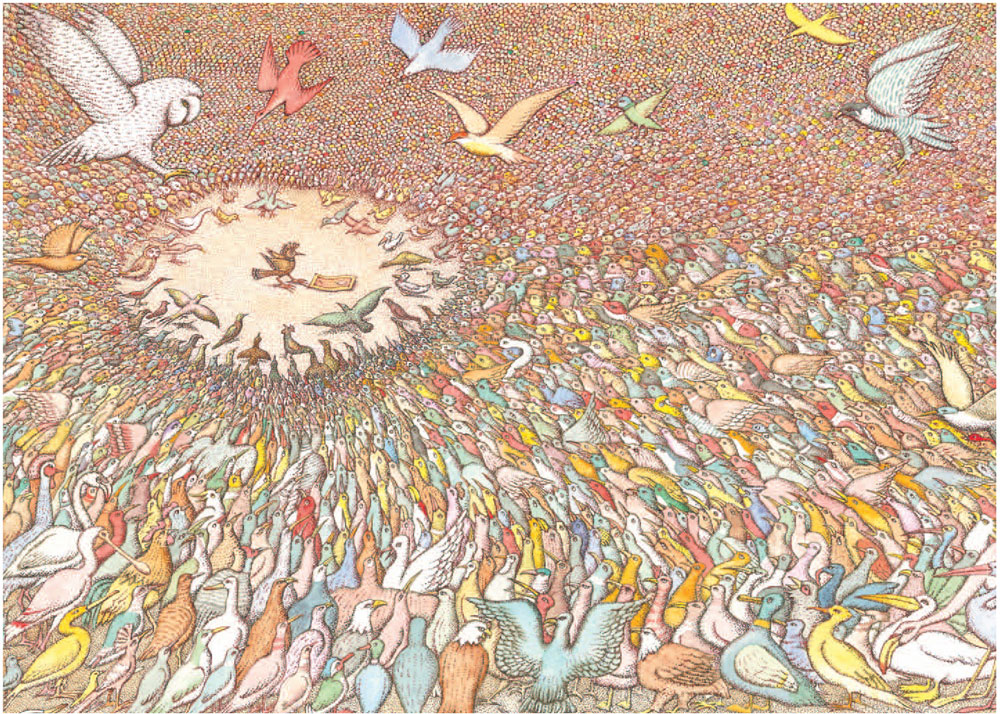
Simorgh: Thirty Birds
‘In the famous epic Persian poem "Conference of the Birds," the birds of the world gather to decide who is to be their king. The hoopoe, the wisest of them all, suggests that they should find the legendary Simorgh, a mythical Persian bird. The hoopoe leads the birds, each of whom represent a human fault which prevents man from attaining enlightenment. When the group of thirty birds finally reach the dwelling place of the Simorgh, all they find is a lake in which they see their own reflection. They realize that they were the Simorgh (which in Persian literally means "thirty birds") all along. The leader they sought was each and every one of them.’
‘Hundreds of birds embark on a perilous journey across seven treacherous valleys in search of a king who can right the wrongs in their world. They are led by the poet Attar, who has been transformed into a sharp-beaked, crested hoopoe. The troubles that spur them into flight — "Anarchy — discontent — upheaval! Desperate fights over territory, water, and food! Poisoned air! Unhappiness!" — are of course all too familiar in our world.’
As I continue to further and deepen my research on “Values-led Leadership and the Common Good” I came across the story of Simorgh as depicted in Farid ud-Din Attar’s famous 12th century epic poem, The Conference of the Birds (منطقالطیر).
I believe Attar’s classic Persian story can teach us a lot about the principles of vision, participation, values-led and collective leadership we must embody in order to build a better and more harmonious world.
So, here, I want to share with you what Attar has to offer on collective leadership, love and spirituality- so much missing today and so much needed to enable us together to build a better world: A world for the common good. These are the seeds that Attar and others like him have planted, and have germinated over centuries, growing into a garden into which you are about to step into.
In short, the more I read, the more I began to love this new discovery: Thus, my excitement to share it with you.
“Now I am made one with You and from that Union my heart is consumed with rapture and my tongue is bewildered. By union, I have been merged in the Unity, I am become altogether apart from all else. I am You and You are I - nay, not I, all is altogether You. I have passed away, ‘I’ and ‘You’ no more exist. We have become one and I have become altogether You”--Farid ud-Din Attar
First, a brief note on Attar (ca. 1142 - ca. 1220): Attar was born in Neishapour, in the Iranian province of Khorasan, and died in the same city. As the great Inayat Khan has observed, Attar is one of the most ancient poets of Persia, and it is no exaggeration to say that the work of Attar has been the inspiration of Rumi and of many spiritual souls and many poets of Persia. Rumi praises Attar as such: "Attar roamed the seven cities of love-we are still just in one alley."

Farid ud-Din Attar
Photo: onetruename.com
Attar has pointed out the way to the ultimate aim of life, by making a sort of picture in a poetic form. He was very prolific. The number of his works is said to equal the number of suras in the Qur'an, i.e., one hundred and fourteen. About thirty or so survive, among them, moral treaties, love stories, prose biographies of saints, a collection of quatrains, the most magnificent Mantiq at-Tayr ("The Bird of the Sky"), known in English as the Conference of the Birds, from which we have taken the idea of the "Blue Bird" or the "Bird of the Sky." This is a very ancient teaching, through the use of the Persian word "Sky." This points out that every soul has a capacity which may be called the sky, and this capacity can accommodate the world or the heaven, whatever it would partake of and hold in itself.
As Pir-o-Murshid Hazrat Inayat Khan has remarked, “When one walks in the crowd, what does one see? One sees numerous faces. I call them various attitudes. All that you see in individuals, all that stands before you, has expression, has atmosphere and has form. If you call it by one name, it is the attitude: the attitude they have towards life, right or wrong, good or bad. Whatever attitude they have, they are themselves that attitude.
“Plainly speaking, whatever one makes of oneself, one becomes that- a source of happiness or unhappiness, all is in man himself. When he is not aware of this, then he is not able to arrange his life; and as he becomes more acquainted with this secret, he gains mastery, and it is the process with which this mastery is attained which is the only fulfilment of his life. It is that process which is explained by Attar in his work with the seven valleys through which this Bird of the sky had passed.”

Resting place of Attar, Neishapour
Photo: sufimap.com
The Conference of the Birds - Simurgh portrayed by Attar

Conference of the Birds
Photo: images-amazon.com
To understand Simorgh as portrayed by Attar, we first have to know the story as constructed in this poem. Here is a short summary:
The tale begins with a time of chaos in a society of birds., very similar, I must say, to today’s society of humans. The birds see that other animal groups have clear leaders, and grow concerned that they do not have a leader of their own. They have no king, so to say. One bird, the Hoopoe (هدهد), assures his community that he knows of a leader named the Simorgh (سیمرغ).
Hoopoe offers to take the birds on a journey to meet their future leader – and yet, many resist, offering various excuses. But the savvy Hoopoe identifies each bird’s interests, negotiates, and eventually thousands of birds head off to find Simorgh.
But the journey comes out to be very difficult. They pass through seven valleys, namely:
1- The Valley of the Quest,
2- The Valley of Love,
3- The Valley of Understanding,
4- The Valley of Independence and Detachment,
5- The Valley of Unity,
6- The Valley of Astonishment and Bewilderment,
7- The Valley of Deprivation and Death.
In each of these stages, there are several events by which the birds learn different lessons. One by one, in each of these valleys, birds give up the journey, not being able to endure it. Only thirty birds are left when they cross their final valley and reach the land of Simorgh. There, only what they see is their own reflection in a lake, and not the mythical Simorgh.
There in the Simorgh's radiant face they saw
Themselves, the Simorgh of the world - with awe
They gazed, and dared at last to comprehend
They were the Simorgh and the journey's end.
They see the Simorgh - at themselves they stare,
And see a second Simorgh standing there;
They look at both and see the two are one,
That this is that, that this, the goal is won.
They ask (but inwardly; they make no sound)
The meaning of these mysteries that confound
Their puzzled ignorance - how is it true
That 'we' is not distinguished here from 'you'?
As "Si" means thirty and "Morgh" means birds in Persian, so Si-morgh means Thirty Birds. Interestingly, these birds found their king in their Collective Self. This Collective Self appears when one and many are the same thing.
In conclusion, I believe Attar provides a direct refutation of the current and prevailing cynicism and hopelessness that has so tragically penetrated the minds of so many in the world. Reclaiming those values of collective leadership and vision highlighted in The Conference of the Birds can help strengthen ourselves, our community, our society, and our world, giving us all a common language through which to relate to one another.
Wish to read and learn more?
The Conference of the Birds: Peter Sis: 9780143124245: Amazon.com: Books
